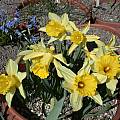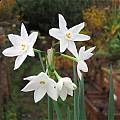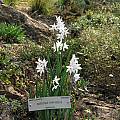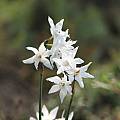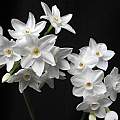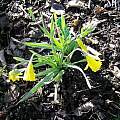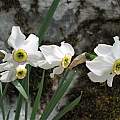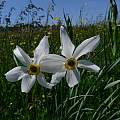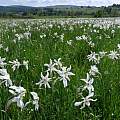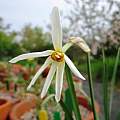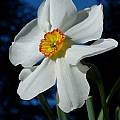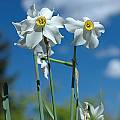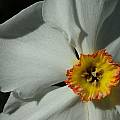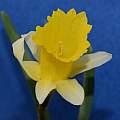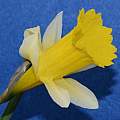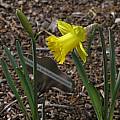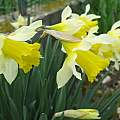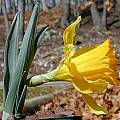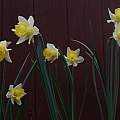Narcissus is a genus in the Amaryllidaceae family native to Europe, North Africa and Asia. As a popular garden plant it has been hybridized heavily, and there are new ones being introduced every year. Among all of the attention focused on the hybrids, species Narcissus tend to be overlooked. That's a shame, since many of the species have a delicate charm of their own.
Unfortunately, the naming of species Narcissus is a mess. Bulb expert Brian Mathew reports that they can be difficult to classify, with various authors identifying anywhere from 26 species to more than 60. Because Narcissus have been in cultivation for so long, some plants believed to be species are known only in gardens, with no known wild populations to verify them. All of this confusion is reflected in commerce, where bulbs may be sold under a variety of different names. We've done our best to classify the following photos, but this page is definitely a work in progress. Please let us know if you find an error. The species P will be found below.
Note: The letter and number codes after each species name refer to Brian Mathew's taxonomy of Narcissus species, which you can read here.
Narcissus pachybolbos. 2a(i)B - white tazetta-like flowers. Has a large bulb -- up to 7 cm wide at maturity. From Algeria and Morocco.
Narcissus palearensis. 1d(i) - green-leaved jonquils. Looks like N. jonquilla but 1-3 flowers per umbel. Spain
Narcissus pallidiflorus. 1b(B) - classic daffodils with large flowers. Pale cream or yellow flowers, twisted petals and a jagged-edged corona. Grows on the border between Spain and France. The flower is quite large, but its stems are rather short. The illustrated plants were grown from wild-collected seed and show a little variation in color, some being all pale yellow and some showing the more typical darker corona. Grown in a raised bed in Oregon, flowering in March. Photo by Jane McGary.
Narcissus panizzianus. 2a(i)B - white tazetta-like flowers. Gray-green leaves and pointed petals. Ranges from Italy to Portugal.
Narcissus papyraceus. 2a(i)B The most commonly grown species of Narcissus is probably the paperwhite, Narcissus papyraceus. The strongly scented multi-flowered umbels are commonly available near the end of fall at nurseries, mail order garden suppliers, and supermarkets right along with amaryllis (Hippeastrum) for forcing indoors. However in mild Mediterranean climates (USDA zone 8+) it can be grown outdoors. It grows wild from southern Portugal eastwards to Yugoslavia and Greece, Cyprus, Morocco, Algeria and western Mediterranean islands and is reportedly naturalized in parts of Italy and parts of the US. Bloom time is probably variable when it is planted in the ground as it doesn't require a chilling period to flower, and so is said to bloom anywhere from late Autumn to spring. The flowers are around an inch in diameter with small cups a quarter of an inch wide and pointed to ovoid perianth segments. As many as 20 flowers have been observed in the umbel on a single scape in healthy happy individuals. It is named after papyrus, from which the ancient Egyptians made their paper - thus the common name "Paper-white".
Photo #1 by David Victor. Photos #2-3 were taken by Nhu Nguyen at the UC Botanical Garden. The plant material pictured came from Morocco. Photo #4 shows two different wild collected forms in Italy by Angelo Porcelli: the one on the left has larger and pointed tepals and the one on the right has smaller and rounded tepals. Although present in Italy here and there, this species is probably not native but naturalized from ancient times. When in contact with Narcissus tazetta it hybridizes creating Narcissus tazetta italicus, which is a actually a triploid sterile hybrid.
Narcissus parviflorus. 1b(A) - classic daffodils with small flowers. Pendent flowers, with cream colored petals and a deep yellow corona. Southwest France.
Narcissus patulus. 2a(i)A - colored tazetta-like flowers. White petals slightly reflexed, deep yellow corona. From France to the Balkans.
Narcissus perez-chiscanoi. 1b(B) - classic daffodils with large flowers. Similar to N. obvallaris. Spain. Photo by Ralph Carpenter.
Narcissus poeticus (syn. N. angustifolius). 1a - "Pheasant's eye" flowers. Blooms in spring, and has a relatively wide, shallow corona, with wide white petals. It ranges from Greece to France. Bulb explorer Janis Ruksans, in his book Buried Treasures, describes a valley in western Ukraine that contains the northernmost wild population of N. poeticus. He says the species was formerly common in meadows in the area, but most were lost when the meadows were converted to farms. At the time Ruksans visited, the valley was near the border of the Soviet Union, and required special permission to visit. It's now a tourist attraction. You can read more here. Some botanists argue that there are as many as ten different species closely related to N. poeticus. Mathew recognizes two (N. poeticus itself and N. radiiflorus) and classifies the rest as variants. Linnaeus christened this the "poets' daffodil" because he imagined it was the flower the ancient Greek poets were thinking of when they wrote the myth of Narcissus (who fell in love with his reflection in a pool, died and caused flowers to grow on the spot). If you connected the name with William Wordsworth the Lake District poet, his verse about daffodils was composed in 1804 and this species was named in 1753. Photo by Hans Joschko.
Narcissus poeticus subsp. radiiflorus. 1a - "Pheasant's eye" flowers. The flowers are more starry in shape than poeticus, with the petals not overlapping. First two photos are of plants in habitat in Southern France by Mario Klesczewski. Third photo by Ralph Carpenter of a pot grown plant, flowering in April of 2014.
Narcissus poeticus subsp. radiiflorus var. exertus: Flat corona, yellow with a red edge. Switzerland and southern France.
Narcissus poeticus subsp. radiiflorus var. poetarum: Red corona, origin unknown.
Narcissus poeticus subsp. radiiflorus var. radiiflorus: Shallow corona less than 1 cm across. Switzerland, Austria, and the Balkans.
Narcissus poeticus subsp. radiiflorus var. stellaris: Slightly larger corona than N. poeticus subsp. radiiflorus. Central, eastern Europe.
Narcissus poeticus var. hellenicus: Flowers about 4.5 cm, reflexed petals. From Greece.
Narcissus poeticus var. majalis: White corona with a red edge, France.
Narcissus poeticus var. poeticus: flowers up to 7 cm in diameter, from France and Italy.
Narcissus poeticus var. recurvus: Greenish-yellow corona with a red edge, Switzerland. Wild narcissus, with a very pleasant scent, growing in open woods on the hills; they like a shady position and moist soil. This is the last blossoming among narcissus here, from the end of April to late May. Photos by Giorgio Pozzi, May 2005.
Narcissus poeticus var. verbanensis: Pointed petals, small flowers. Italy.
Narcissus polyanthus. 2a(i)B - white tazetta-like flowers. From southern France.
Narcissus portensis. 1b(A) - classic daffodils with small flowers. Up to 20 cm high, bright yellow. From northern Portugal and central Spain.
Narcissus primigenius. 1b(B) - classic daffodils with large flowers. Similar to N. nobilis. Spain. Photos by Arnold Trachtenberg.
Narcissus provincialis. 1b(A) - classic daffodils with small flowers. Similar to N. minor, with slightly larger flowers. Southern France.
Narcissus pseudonarcissus see the Narcissus pseudonarcissus page. Representative photos of this species by Mary Sue Ittner, Angelo Porcelli, John Lonsdale and David Pilling.
Narcissus pumilus. 1b(A) - classic daffodils with small flowers. Looks like N. nanus, but flowers are bright yellow. Origin unknown.
Narcissus index - Overview of the Narcissus species - Narcissus Species A-B - Narcissus Species C - Narcissus Species D-J - Narcissus Species K-O - Narcissus Species P - Narcissus Species Q-Z - Narcissus hybrids - Division 1 - Division 2 - Division 3 - Division 4 - Division 5 - Division 6 - Division 7 - Division 8 - Division 9 - Division 10 - Division 11 - Division 12 - Miniatures
